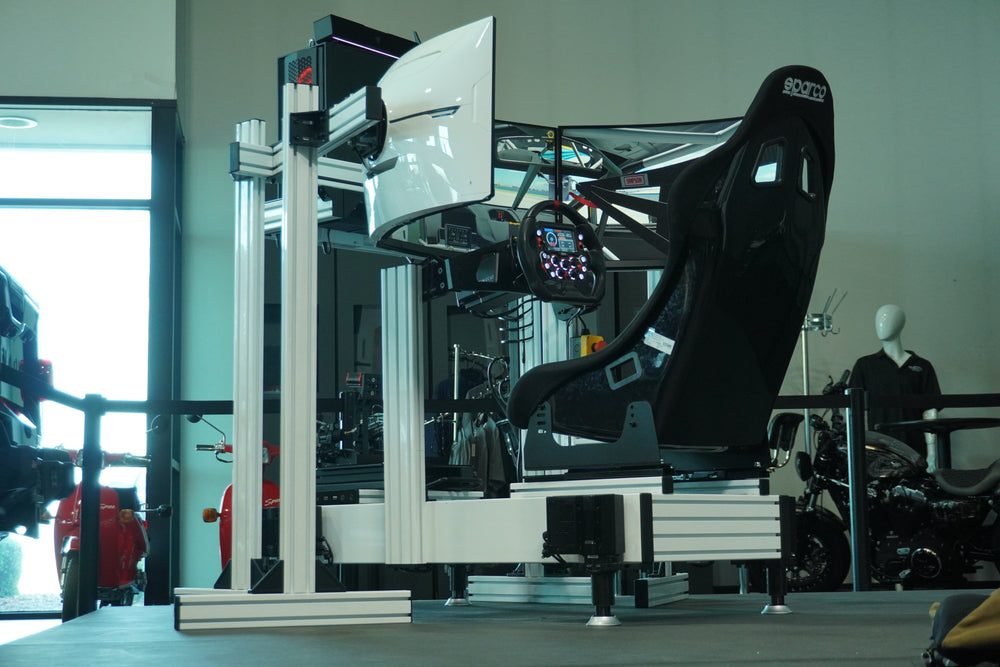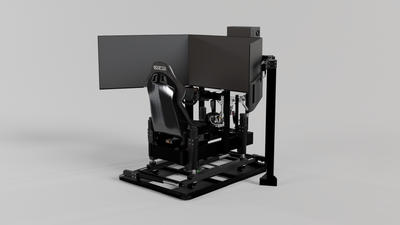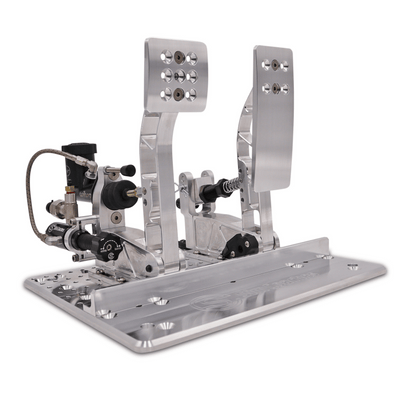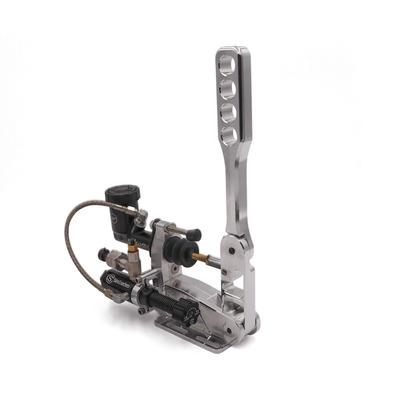Sim racing has transformed from a niche hobby into a legitimate motorsport discipline that's attracting professional drivers, esports athletes, and racing enthusiasts worldwide. But what exactly is sim racing, and why has it become such a powerful force in the racing world?
In this comprehensive guide, we'll explore everything you need to know about sim racing - from its humble beginnings to its current status as a professional sport that's reshaping how we think about racing.
What is Sim Racing?
Sim racing (simulation racing) is the practice of using computer software and specialized hardware to recreate authentic racing experiences. Unlike arcade-style racing games, sim racing focuses on realistic physics, authentic car behavior, and accurate track reproduction to mirror real-world motorsport as closely as possible.
Modern sim racing combines:
- Advanced physics engines that calculate tire grip, aerodynamics, and suspension behavior
- Accurate track laser-scanning that recreates every bump and corner of real racing circuits
- Professional-grade hardware including force feedback steering wheels, hydraulic pedals, and motion systems
- Online competitive racing with structured leagues and official championships
The result is an experience so realistic that professional Formula 1, NASCAR, and IndyCar drivers use sim racing for training and car development.
Sim Racing vs Gaming: Understanding the Difference
While sim racing uses gaming technology, it serves a fundamentally different purpose:
| Racing Games | Sim Racing |
|---|---|
| Focus on fun and accessibility | Focus on realism and authenticity |
| Simplified physics for easier play | Complex physics matching real cars |
| Controller-friendly design | Requires specialized hardware |
| Arcade-style progression | Skill-based improvement like real racing |
The Evolution of Sim Racing
Early Days (1970s-1990s)
Sim racing began in the 1970s with basic arcade machines, but the real foundation was laid in the 1990s with home computer simulations. Early pioneers like Indianapolis 500: The Simulation (1989) and Formula One Grand Prix (1991) established the core principles of realistic racing simulation.
The Modern Era (2000s-Present)
The 2000s brought revolutionary advances:
- iRacing (2008): Introduced professional-grade online racing with official licensing
- Assetto Corsa (2013): Delivered unprecedented physics accuracy
- Professional adoption: Real racing teams began using sim racing for development
- Esports integration: Major racing series launched official sim racing championships
The COVID-19 Catalyst
The 2020 pandemic accelerated sim racing adoption when real racing was suspended. Professional drivers competed in virtual races broadcast on major sports networks, introducing millions to the legitimacy of sim racing competition.
Essential Sim Racing Hardware
Professional sim racing requires specialized hardware that replicates the feel and feedback of real race cars:
Steering Wheels and Force Feedback
Force feedback wheels are the foundation of sim racing. These systems transmit road texture, tire grip levels, and car behavior through the steering wheel, just like real race cars. Professional-grade wheels can generate over 25 Nm of torque for authentic feedback.
Pedals: The Critical Control Interface
Pedals are arguably the most important component for realistic sim racing. Hydraulic brake pedals offer the ultimate in authenticity, using actual hydraulic pressure to replicate real race car brake feel. This technology provides:
- Authentic brake modulation for precise control
- Sub-1ms response times for competitive advantage
- Professional-grade consistency matching real race cars
Racing Rigs and Cockpits
A proper racing rig provides the stable platform necessary for consistent performance. Professional rigs feature adjustable seating positions, proper pedal mounting, and wheel positioning that matches real race cars.
Displays and Virtual Reality
Modern sim racing uses multi-monitor setups or VR headsets to provide proper peripheral vision and depth perception essential for racing at speed.
The Competitive Sim Racing Scene
Professional Esports Championships
Sim racing has developed a robust competitive ecosystem:
- Formula 1 Esports Series: Official F1 championship with teams fielding professional sim racers
- NASCAR iRacing Series: Officially sanctioned NASCAR competition
- 24 Hours of Le Mans Virtual: Premium endurance racing featuring mixed professional and sim racing teams
- GT World Challenge Esports: Professional GT racing championship
Skills Transfer: Virtual to Reality
The skills developed in sim racing directly transfer to real racing:
Proven Benefits:
- Race craft development: Learning overtaking, defensive driving, and strategy
- Track knowledge: Memorizing racing lines and braking points
- Car control: Developing feel for vehicle dynamics
- Mental preparation: Building focus and decision-making under pressure
Professional Driver Integration
Major racing series now incorporate sim racing:
- Driver development programs use sim racing for training
- Race preparation includes virtual practice sessions
- Car setup development starts in the simulator
- Driver evaluation includes sim racing performance metrics
Getting Started in Sim Racing
Choosing Your Platform
Popular sim racing platforms offer different strengths:
- iRacing: Premium online racing with official licensing and structured competition
- Assetto Corsa Competizione: GT racing specialist with exceptional physics
- rFactor 2: Advanced physics and tire modeling
- F1 23: Official Formula 1 simulation with career modes
Hardware Investment Strategy
Building a sim racing setup is an investment in performance:
Learning and Development
Sim racing requires dedicated practice and proper technique:
- Start with driving fundamentals: Learn proper racing lines and braking points
- Practice consistency: Focus on repeatable lap times before chasing speed
- Study data: Use telemetry analysis to identify improvement areas
- Join communities: Learn from experienced sim racers and participate in leagues
The Future of Sim Racing
Technological Advances
Sim racing continues to evolve with cutting-edge technology:
- AI-powered coaching providing real-time feedback and instruction
- Enhanced haptic feedback simulating G-forces and road texture
- Cloud-based computing enabling more complex physics calculations
- Improved VR technology offering better resolution and comfort
Industry Integration
The automotive industry increasingly recognizes sim racing's value:
- Manufacturer involvement: Car companies developing official sim racing programs
- Driver scouting: Racing teams discovering talent through sim racing performance
- Technology transfer: Sim racing innovations improving real car development
Conclusion: Why Sim Racing Matters
Sim racing has evolved far beyond its gaming origins to become a legitimate motorsport discipline that bridges virtual and real racing. Whether you're a racing enthusiast looking to improve your skills, a professional driver seeking training opportunities, or someone discovering the thrill of motorsport, sim racing offers unparalleled access to authentic racing experiences.
The technology has reached a point where the skills developed in virtual racing directly transfer to real tracks, making sim racing not just entertainment, but a legitimate path to motorsport excellence.
Ready to start your sim racing journey?
- Explore our professional racing simulators to find the perfect setup
- Contact our racing experts at 1-702-246-2295 for personalized recommendations
- Schedule a virtual consultation to design your custom sim racing setup
Join the growing community of sim racers who've discovered that virtual racing is real racing. Your racing journey starts here.
Expert tip: Start with quality pedals - they're the most important component for developing proper racing technique. Many beginners focus on the wheel first, but professional drivers know that precise brake control is the foundation of fast lap times.




